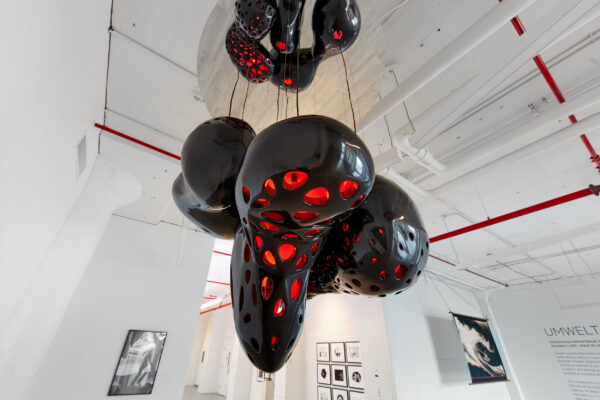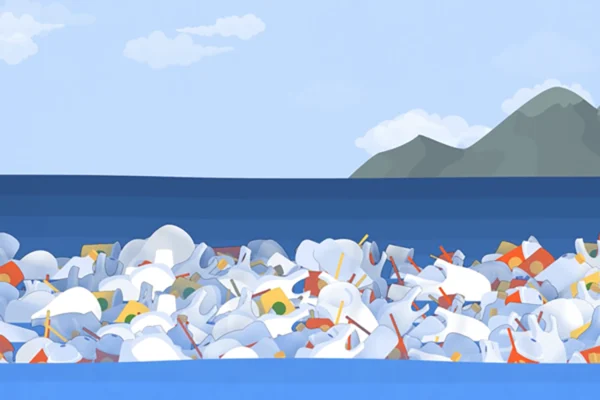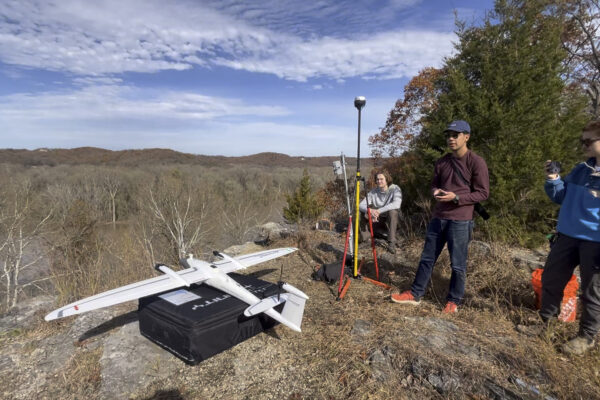Despite being in the beating heart of St. Louis, Washington University has long been entwined with its natural surroundings. With a diverse mix of 6,500 trees scattered over its Danforth Campus, WashU has been recognized as a “Tree Campus USA” since 2010 and last year earned the rare level-three Arboretum status. And WashU’s grounds serve as a vital green corridor and ecosystem for birds and urban wildlife thanks to its proximity to Forest Park. Campus favorites include two “married” red-tail hawks being tracked through the Forest Park Living Lab and WashU’s Living Earth Collaborative.
“The campus offers green spaces for the benefit of all: not just students and staff but also the many types of wildlife that call WashU home,” says Jonathan Losos, the William H. Danforth Distinguished Professor, professor of biology and director of the Living Earth Collaborative. In recent years, species as diverse as red foxes, skunks, opossums, raccoons, shrews and field mice have been spotted on campus, he adds.
Much of the appeal of WashU’s Danforth Campus includes the natural nooks it affords visitors. Students regularly carve out spots near the Elizabeth Gray Danforth Butterfly Garden in the spring or sprawl under trees when soft yellow ginkgo leaves carpet the ground in the fall. Near Olin Library, the Japanese flowering crabapple forms a shady dome, the ultimate reading (or napping) spot on hot months.
Green spaces and learning go hand in hand. Indeed, there is growing consensus that access to green space fosters learning through rejuvenation of attention, more active engagement and relief of stress.
But it’s not only students who benefit from embracing nature. WashU’s faculty find inspiration there as well.
It starts with taking on a challenge or recognizing a problem and trying to think outside the box. In this case, the emphasis is on the word “outside.”
No matter if they teach business, engineering, art or science, faculty at WashU find new ideas and innovative solutions by looking to the natural world.
Below are just a few examples.
Shifting the cultural narrative
Patricia Olynyk is an artist working with science and technology-related themes, meaning she often works with scientists, humanists and technicians to explore a wide variety of topics, including those that involve mathematical patterns in nature.
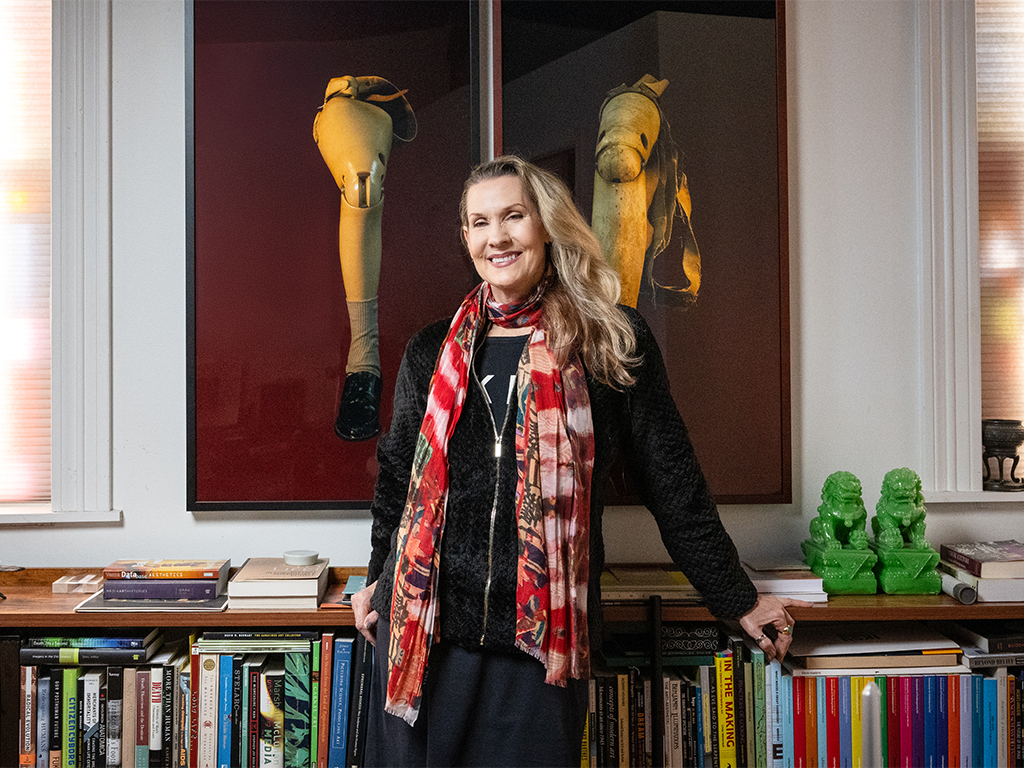
She also creates art that “makes you aware of your own presence within the environment,” she says, speaking about her Sensing Terrains and Dark Skies installations.
Olynyk, the Florence and Frank Bush Professor at the Sam Fox School of Design & Visual Arts, is often stratifying this space between the mathematical and the “umwelt,” our perceptional environment.
In the case of Sensing Terrains — Olynyk’s large-scale exhibition at the National Academy of Sciences that included silk prints of massive blown-up images of scanning electron micrographs (SEMs) of human and nonhuman specimens and piped-in sounds from Japanese gardens designed to “tickle the senses” — the idea was to offer “a very specific choreography of nature.”
The point, she says, is “to draw attention to the fact that the state of being sensate is not uniquely human.” Olynyk wants to get people thinking about how their senses experience nature in different forms. “What does that advance in terms of where we are in this precarious time?” she asks.
In Dark Skies, released in 2016, she was “inspired by the stunning cinematic moment of the sun going down and my concern about our loss of dark skies globally due in large part to light pollution.” The installation is the color of sunset, but on a very blurry, bumpy surface, with trails of dark colors blending into the reds and yellows. It’s meant to evoke where light meets night, and where human artificial light swallows it.
In another project, Oculus, she offers a massive amoeba-like sculpture with red eyes scattered like jewels, imposing a sense of surveillance but also an out-of-scale view of what could be a genetically modified fruit fly.
“I’m trying to generate more interesting questions about the complex world we live in.”
Patricia Olynyk
Olynyk mapped out grid patterns based on mathematics of natural forms, and then she distorted those forms, amplifying certain parts of the grid while reducing others. There are no straight answers about what the viewer should take away from Olynyk’s work. Her goal instead is to get people questioning.
“I’m trying to generate more interesting questions about the complex world we live in,” she says.
Nor does she limit herself to any one medium, type of art or science. Her most recent work, featured at Bruno David Gallery in St. Louis last fall, was a collaboration with cinematographer Adam Hogan. The video, “Black Swan in Three Variations,” explores what individuals can gain from highly improbable “black swan” events, touching on financial collapses, introduction of AI and even the sinking of the Titanic.
Pulling people into new perspectives on major events is another theme to her work. She constantly thinks about climate change and the need to shift the conversation away from just “awareness” and to get people to envision new futures. “Until you imagine a new world, people will be paralyzed,” she says. “We need to shift the cultural imagination over to new narratives that imagine where we’re all going to have to live in 50 years.”
The modest mussel
Synthetic biology is revolutionizing how we “code” biological systems — enabling engineers to create new proteins, tinker with metabolic pathways, hijack microbes’ biosynthesis power. It’s like trying to set up a biological circuit board. And when it all comes together, scientists can potentially take these biological “switches” and program microbes (fungi, yeast, bacteria, algae) to produce useful materials, food or fuel.
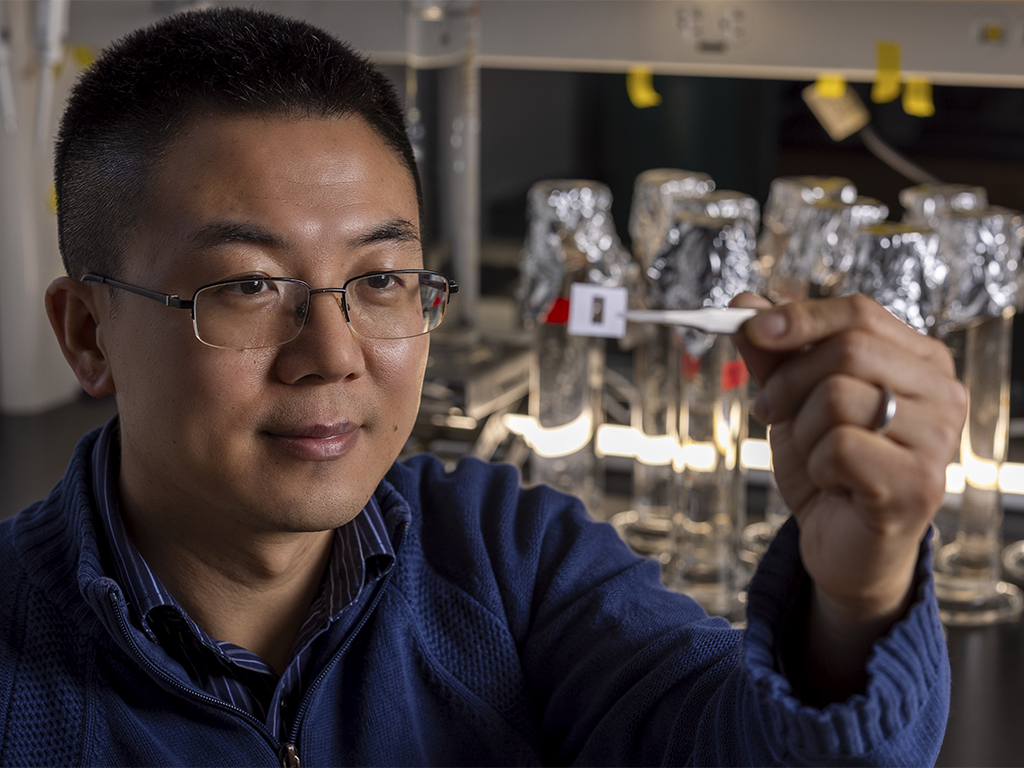
Imagine the process used to brew beer — tanks of yeast biochemically nudged to ferment sugars to produce alcohol — applied to pretty much everything. It sounds like a science fiction dream, but it’s becoming more viable every day thanks to the work of Fuzhong Zhang, the Francis F. Ahmann Professor in the Department of Energy, Environmental & Chemical Engineering in the McKelvey School of Engineering.
Zhang can’t help but take inspiration from nature, because in many cases, “nature” has already solved a problem for him. Take, for instance, the challenge of mass-producing fiber materials to replace petroleum-derived nylon and polyesters. Spiders make some of the strongest and toughest fibers on the planet while being biodegradable, but the solitary and predatory arachnids can’t really be put to work.
Over the past decade, Zhang has been “programming” bacteria to produce fibers that are similar to real spider silk. But to make fibers stronger than spider silk and have far higher yields, he and his team turned to sticky critters: mussels. The proteins extruded by the foot of a mussel are very “sticky,” making them a fantastic molecular tool for material innovation purposes.
Mussels produce small threads at the bottom of their cones, which serve as their sticky “feet.” “We use these sticky ‘feet’ to stick silk proteins together and, ultimately, make our microbe-produced fibers stronger,” Zhang says. Taking the mussel-foot protein and fusing it to spider-silk proteins enabled Zhang and colleagues to finally crack the code to high yield and strong threads, which can be used in higher-end protective textiles such as bulletproof vests.
Taking cues from nature means that researchers can often solve more than one problem at a time. Zhang’s team also used the mussel-foot/spider-protein combo to make biocompatible adhesives for surgical glues. Traditional medical adhesives are either too weak for surgical repair or can cause allergic reactions, notes Zhang. “But our mussel-inspired protein adhesives are both strong and biocompatible, potentially suitable for a wide range of medical repair applications,” he says. If all goes well in clinical trials, that mussel-inspired glue could close wounds in various organs, saving time and potentially lives.
Zhang takes his work seriously. Not only is he innovating in synthetic biology, but he is also leading the way to a future where humanity can eventually replace the plastics that are choking the planet. As co-director of the Synthetic Biology Manufacturing of Advanced Materials Research Center (SMARC), he and his engineering colleagues at McKelvey are developing new classes of biologically synthesized, mechanically strong and biodegradable materials that harness themes from nature to replace traditional petroleum-derived plastics.
The music of nature
The “Pines of Rome” is a famous work of music from the 1920s by Italian composer Ottorino Respighi. The “Pini di Roma” has a sweeping sound, almost regal in quality, to evoke the stately pines around the city of Rome. When Christopher Stark decided to create a new version of this classical composition, he visited the sites in Italy and found much had changed over the last century. Tragically, the pines are dying because of an invasive parasitic insect.
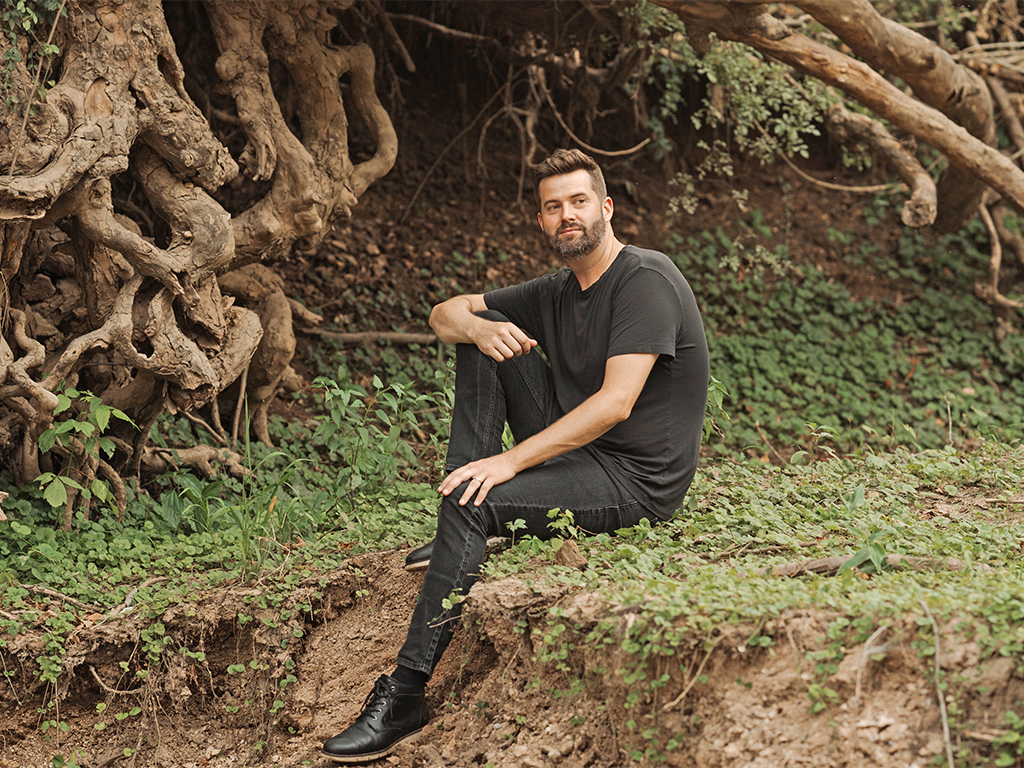
“Other Pines,” written by Stark nearly 100 years later, replaces regal with ominous sounds to evoke the disjointed feeling of living in a world afflicted by climate change.
Stark, associate professor of music com–position in Arts & Sciences, has never stopped thinking about nature and change since he started his career. “Being from the West, it’s just something I think about,” says Stark, who is from Montana. “So much of music is physical and mathematical in the same ways that a lot of natural phenomena are.”
His most recent work uses field recordings of fire, wind and water. Released in 2021, Stark’s “Fire Ecologies” composition resulted from a trip to the West Coast during wildfire season in 2020. He recorded clips of wind in deciduous and coniferous forests to get a sense of how the sounds compare; he recorded the crackle of fire, as close as he could get.
Stark’s work has been about climate change, but he’s also using nature as inspiration in a more general way. He thinks about how to evoke emotion in music, and sounds of nature can most certainly do that in a variety of ways. “Do I want to leave the audience feeling uneasy? Or do I want to leave them with wonder and awe and motivation to save nature?” he asks, while exploring the juxtaposition.
“Do I want to leave the audience feeling uneasy? Or do I want to leave them with wonder and awe and motivation to save nature?”
Christopher Stark
Composers learn classical techniques to help them evoke tension in their work, and Stark creates similar effects with his landscape recordings. In his “Language of Landscapes,” for instance, he used a recording from a lake — the sound of water lapping on the shores — and he slowly removed information from the digital audio file, so the sound starts to feel more uneasy and distorted, to give “the idea that this natural resource is eroding,” he says.
“I really love looking for analogies like that, between musical techniques and emotions, or sociopolitical commentaries,” he says.
Many people hear contemporary classical music and think it’s “difficult” or “noisy,” but Stark notes that “the context of noise can change so radically from upsetting to pacifying.” The sounds of fire, wind and water are complex and “noisy,” but just as equally have the potential to calm.
“It’s fun to try to create those sounds with instruments to evoke those same sounds coming from natural phenomena,” he says. “That dichotomy of what is synthetic and what is natural is really interesting.”
The messy meandering
One lesson from Hurricane Helene that flooded North Carolina last fall is that weather events will be increasingly unpredictable and extreme as the world feels the heat from climate change. That’s why Claire Masteller’s approach to studying river systems is about “embracing the variability and messiness of the natural world,” she says.

The more humanity tries to tighten its grip on natural forces, the more unforeseen consequences can arise downstream (quite literally in this case). So Masteller, assistant professor of earth, environmental, and planetary sciences in Arts & Sciences, is studying the rules governing rivers: what makes some stay narrow, while others lose all cohesion and flood.
Her own journey into “geomorphology” meanders like a river. Masteller was a “Jersey Shore” girl, growing up on barrier islands that dot the lower coast of New Jersey. She was a first-generation college student when she attended University of Pennsylvania, dabbling in subjects from fine arts to international relations until she found her place in the geosciences. She went on to earn a doctorate on the opposite coast, at the University of California, Santa Cruz, and then traveled overseas for postdoc opportunities in Germany. Finally, Masteller landed in St. Louis, the ultimate river region, featuring the confluence of two major North American rivers: the Mississippi and Missouri.
She couldn’t have picked a better place to get down to the “nitty-gritty detail” of how rivers work, right down to how a single piece of sediment moves. She can do that thanks to the “mini river” in her lab, a room-length plexiglass flume that she uses to run experiments on erosion in gravel riverbeds. Her experiments are informed by real-world data and sampling, including satellite data from major events like Helene or local occurrences such as urban flooding in Southern Illinois.
Scientists have a good handle on understanding the average behavior of stable river systems, but under extreme conditions, the rules change. Therefore, in her lab, Masteller is trying to determine how hard weather can push a river system before it moves away from the average.
In the case of Helene, all the rivers in North Carolina experienced the “flood of record.” Basically, it was “the biggest flood the gauge has seen since the gauge was installed,” she says. Some of the rivers completely changed their paths following the flooding in North Carolina, but others showed far less widespread change.
Masteller wants to understand why some rivers are resilient, keeping their deep channels and sticking to their original paths after a major flood, while others end up widening and redirecting.
How to accurately predict which rivers will respond to these environmental extremes is more of an emerging field in the science, she says. She has a few explanations still under peer review. When it comes to the resiliency of rivers, she is evaluating whether the frequency of flooding matters, because the more a riverbed is constantly jumbled, the less chance it gets to stabilize between flood events. Mudslides may also be a factor “that might compound to make the river more sensitive,” she says. Research by Masteller and colleagues on these mechanisms of geomorphology will be the next step in the coming years.
Studying the “why” behind shifting rivers and other “earth surface hazards” humans experience means embracing the messy, meandering ways the earth moves and delving into the mechanisms behind that movement. “Understanding that is the underlying thrust of a lot of the work we do.”
Making sutures out of snake teeth
As is often the way with a group of scientists, the researchers and students in Guy Genin’s biomedical engineering lab started talking one day about how a velociraptor might kill its prey, which led to another remarkable discussion of the ways modern predators kill their prey, which then led to something even more surprising: a new way to help people recover from tendon surgery.

You wouldn’t think an image of a dinosaur ripping into flesh would inspire biomedical design. But Genin, the Harold and Kathleen Faught Professor of Mechanical Engineering in the McKelvey School of Engineering, can find surprising inspiration from the natural world.
Rotator cuff surgery is notorious for its failure rate; anywhere between 20%–94% of surgeries fail, most commonly because sutures tear through tendons at “grasping points.” Those grasping points are important, and with the current medical design, they resemble straight-backed shark teeth. That brings us back to the discussion of predators, not all of which “tear” the flesh of prey. During the dinosaur talk in Genin’s lab, a postdoc named Lester Smith (now a professor at Indiana University) noted that pythons grasp and drag their prey but don’t tear the flesh.
“Pythons actually grip onto their prey; they suffocate the prey and then ingest them,” Genin cheerfully intones. Cheerful because the result of this chatter is a new device using python-teeth–style hooks as the backboard to the sutures.
“Even if the force is distributed, the maximum force that each point can take is higher if you have a curved tooth than if you have a straight tooth.”
Guy Genin
Those teeth are curved in such a way that redirects the force downward, pulling that tasty mouse flesh toward the gum instead of ripping it out. Just like a snake can pull, really pull its prey away and into its mouth without tearing, this new design of “python-tooth sutures” can handle the constant pull of tendon as the shoulder is engaged. “Even if the force is distributed, the maximum force that each point can take is higher if you have a curved tooth than if you have a straight tooth,” Genin says.
Genin and colleagues will be fostering python-tooth sutures through a long commercialization process that looms ahead. And that’s only the start of his many endeavors. Genin, who is endlessly fascinated by the mechanical forces that affect the human body — down to the movements of cells and how those forces affect a cell’s function — is a principal investigator in a new international consortium of researchers looking at whether cells can transmit information to each other through tiny vibrations in the scaffold of proteins surrounding them. Good vibes all around.
The garden as studio
Artist Juan William Chávez has a simple idea that can greatly improve a person’s emotional health: Think of a garden as an art studio.
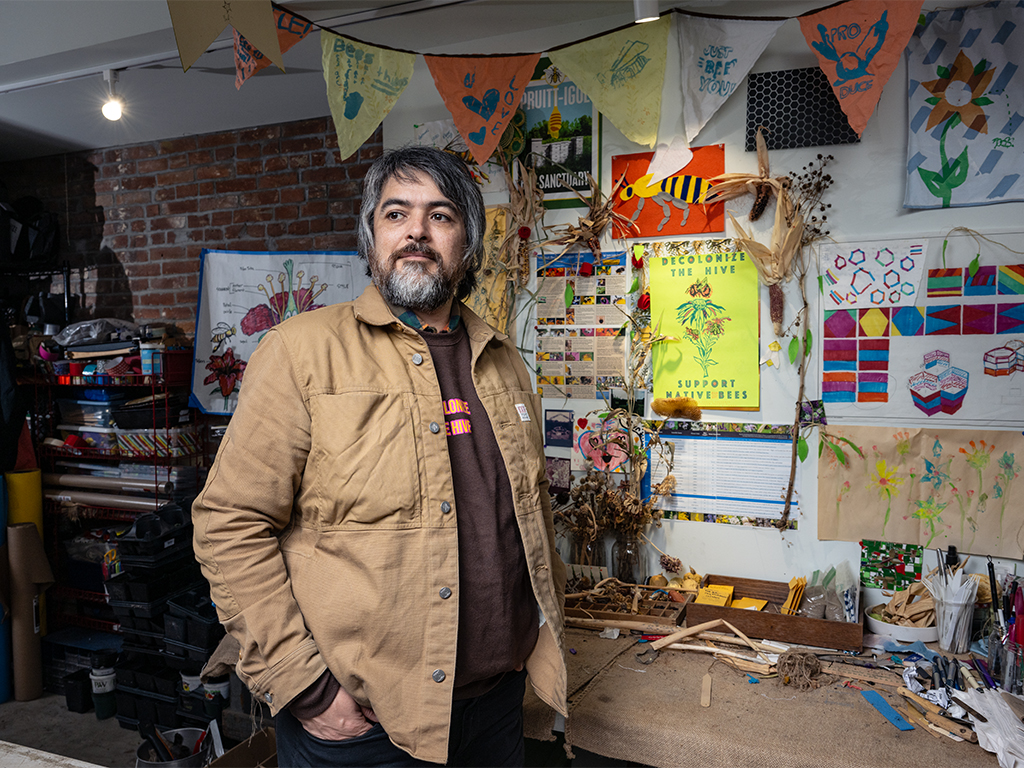
“The garden is one of the most unique spots where you can activate all the senses,” says Chávez, a lecturer at the Sam Fox School of Design & Visual Arts.
Chávez runs a nonprofit called Northside Workshop, where he and collaborators use art, a chemical-free teaching garden and bee sanctuary as a vehicle for community building, self-expression and conservation. His work is being featured this spring as part of the Kemper Art Museum’s exhibit Seeds: Containers of the World to Come.
“Our garden in particular is trying to replicate what is happening through nature,” he says. In that informal, sometimes scruffy locale, people will often emotionally open up and think about their own place in the natural world. “They’re going to tell their story with what they’re growing and their relationship with nature,” Chávez says.
The Northside Workshop has an art studio inside and an acre surrounding the building that serves as an example of permaculture gardening, a type of gardening that replicates more natural conditions. For the past few years, the group has been holding workshops that highlight the importance of native bees, which account for some 80% of all pollination of flowering plants in the wild.
The more local gardeners can offer a comfy home for those bees, the healthier regional ecosystems can become. But Chávez emphasizes that many people will need to rethink how they imagine gardening. “Everyone has some type of access to green space, and usually when we look at green space, we associate it with chores or something to manicure,” he says.
Chávez proposes letting go of that need to control and embracing what’s happening in the garden. He has personally seen the benefits. “My back appreciates it,” he says, noting that his previous studio involved a lot of desk work. “The desk warrior is de-stressing, stretching the legs.”
Along with physical benefits, he appreciates the opportunity for self-reflection the gardening provides. “I feel connected to my ancestors,” says Chávez, whose family is from Peru.
The Northside Workshop offers another benefit: an internship program at WashU, where students are taught about permaculture gardening. The interns tend the garden in amiable silence, as gardening forces them off the phone, puts them in the present tense and grounds them.
“All of a sudden, nature starts unfolding, and nature is medicine,” Chávez says.

